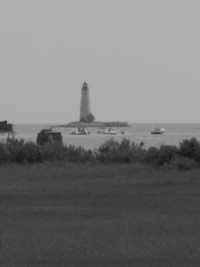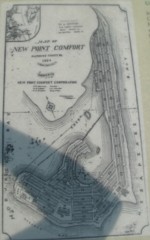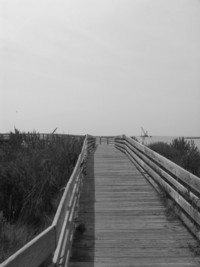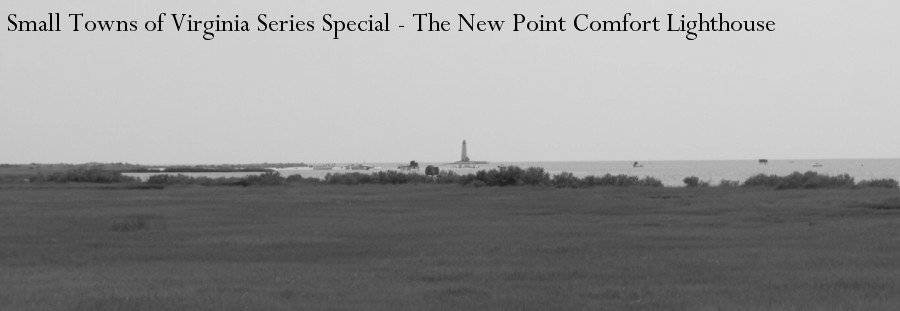 Over
70 years ago, two hurricanes drastically changed the terrain that surrounds
the New Point Comfort Lighthouse. These two storms - which hit less
than one month apart - would isolate the storied New Point Comfort Lighthouse
from the mainland by one half mile. These 1933 hurricanes, along
with similar storms, invasions, and other incidents before and after, have
threatened or even severely damaged the lighthouse. But for over
200 years, the beacon has stood watch over the Chesapeake Bay and has become
a familiar friend to boaters, tourists, and residents alike. Over
70 years ago, two hurricanes drastically changed the terrain that surrounds
the New Point Comfort Lighthouse. These two storms - which hit less
than one month apart - would isolate the storied New Point Comfort Lighthouse
from the mainland by one half mile. These 1933 hurricanes, along
with similar storms, invasions, and other incidents before and after, have
threatened or even severely damaged the lighthouse. But for over
200 years, the beacon has stood watch over the Chesapeake Bay and has become
a familiar friend to boaters, tourists, and residents alike.
At the end of the 18th century, the United States
government had realized the importance of improving the navigation through
the Chesapeake Bay to the numerous ports the bay's waters led to.
Beginning with the completion of the Port Henry lighthouse in 1792 (1),
the government would commission a series of lighthouses with the goal of
improving safety and navigation through the Chesapeake. A decade
later, the Old Point Comfort Lighthouse was completed by Elzy Burroughs.
That same year, Burroughs was again commissioned to build a third Chesapeake
lighthouse at the tip of the New Point Comfort Peninsula, slightly north
of the entrance to Mobjack Bay. (2)
Burroughs would build the lighthouse through three
damaging hurricanes in 1803 and 1804. The New Point Comfort Light
began service on January 17, 1805 when Burroughs first lit the oil lantern.
The completed lighthouse stands at a height of 58 feet and has an octagonal
shape. The structure was built completely out of sandstone, and its
design closely resembles the two Chesapeake lighthouses that preceded it,
Old Point Comfort and Port Henry.
For over the next century, the New Point Comfort
light weathered a series of storms by both nature and man. Less than
a decade after Burroughs completed the structure, the light was captured
by the British in the War of 1812. Held by the British Army for only
four weeks, the army ransacked the grounds, burned down the lightkeeper's
house and oil vault, and did considerable damage to the lantern and the
lighthouse itself. Burroughs was asked to repair the grounds, light
and rebuild the keeper's home.(1) Nearly fifty years later, another
war, the U.S. Civil War, brought damage to the lighthouse. Confederate
troops rendered the light inoperable in an attempt to hamper Union shipping
through the Chesapeake. Although the damage was significant, it was
less than the damage done by the British years before.
 Just
after the turn of the 20th century, a group called the New Point Comfort
Development Company formed plans to create a bayside resort with the New
Point Comfort Light as the centerpiece. (At left: the 1904 New Point Comfort
Development Company Plans.) Plans called for numerous streets and
residential homes to be built with a grand hotel near the light. (2)
However, various costs, including those to fill in the surrounding salt
marshes and building new beaches, would prove too much and the company
would file for bankruptcy not long after. Just
after the turn of the 20th century, a group called the New Point Comfort
Development Company formed plans to create a bayside resort with the New
Point Comfort Light as the centerpiece. (At left: the 1904 New Point Comfort
Development Company Plans.) Plans called for numerous streets and
residential homes to be built with a grand hotel near the light. (2)
However, various costs, including those to fill in the surrounding salt
marshes and building new beaches, would prove too much and the company
would file for bankruptcy not long after.
Weather would leave the biggest impact to the
fragile peninsula. Hurricanes and Nor'Easters would continue to eat
away at the shoreline. In 1847, the storms began the formation of
a new inlet slightly north of the lighthouse. Five years later, the
inlet had cut through the peninsula and the lighthouse now was the focal
point of a new island. (The inlet can be seen at the top right corner
of the 1904 map.)
However, Mother Nature's biggest blow came from
the wrath of two successive hurricanes in 1933. The first storm on
August 23, 1933 crossed directly over the Chesapeake. Less than a
month later on September 16th, a second hurricane would move off the Virginia
Coast, and although this storm did not cross over the Chesapeake, heavy
winds and storm surge affected the bay. The results of these two
storms, twenty-four days apart, on New Point Comfort and the peninsula
were devastating. The lighthouse - still standing - now sat on its
own tiny island a half mile south of the mainland. A second island
remained between the lighthouse and the tip of the peninsula. If
the 1904 development was built, the damage to the area would have been
even greater.
The United States Coast Guard took over lighthouse
operations six years later in 1939. For the next 24 years, many drastic
changes to the operation of the lighthouse occurred. In 1950, the
light, which was converted to gas in 1919, now ran by electricity.
The Coast Guard built a new light called the 'New Point Comfort Spit Light'
in 1963. Burrough's lighthouse - with limited interruptions since
1805 - was then abandoned.
 The
next 13 years were the most challenging to the lighthouse. Left open
to anyone, the lighthouse and immediate grounds fell victim to vandalization.
The lighthouse did receive status as a National Historic Landmark in 1972,
and three years later the property was acquired by Matthews County.
Immediately after, the New Point Comfort Restoration Committee was formed
and began to restore the lighthouse. In 1981, the restoration efforts
were completed. The
next 13 years were the most challenging to the lighthouse. Left open
to anyone, the lighthouse and immediate grounds fell victim to vandalization.
The lighthouse did receive status as a National Historic Landmark in 1972,
and three years later the property was acquired by Matthews County.
Immediately after, the New Point Comfort Restoration Committee was formed
and began to restore the lighthouse. In 1981, the restoration efforts
were completed.
Today, the lighthouse is still subject to vandalism.
There is no direct or safe public access to the island or the lighthouse.
However, it is accessible by boat. To compensate for the lack of
public access, a boardwalk (shown at right) was constructed at the southern
tip of the peninsula within the New Point Comfort Preserve. The boardwalk
allows for great views of the Chesapeake, surrounding salt marshes, native
wildlife, and of course the New Point Comfort Lighthouse.
Directions:
From Richmond: Follow I-64 East to Exit 220 (VA 33
East). Continue East on VA 33 (19 Miles) to VA 198 South in Glenns.
Follow VA 198 South (22 miles) to VA 14 East near Matthew. Follow
VA 14 East through Matthews and the peninsula to Secondary Route 600.
Route 600 will continue straight while VA 14 bears right. Follow
Route 600 to the highway's end at the boardwalk and Preserve.
Additional Photos:
All photos taken by the webmaster,
August 26, 2006. |

